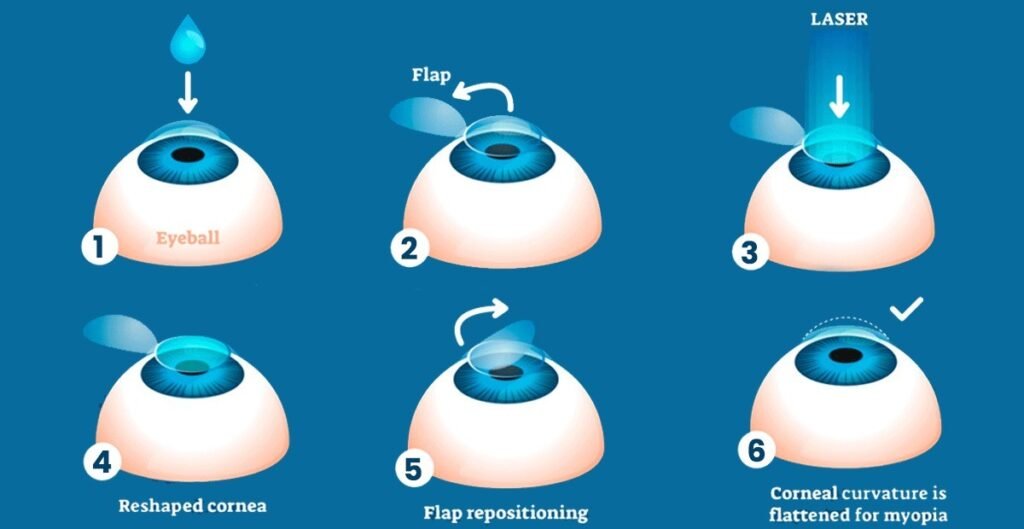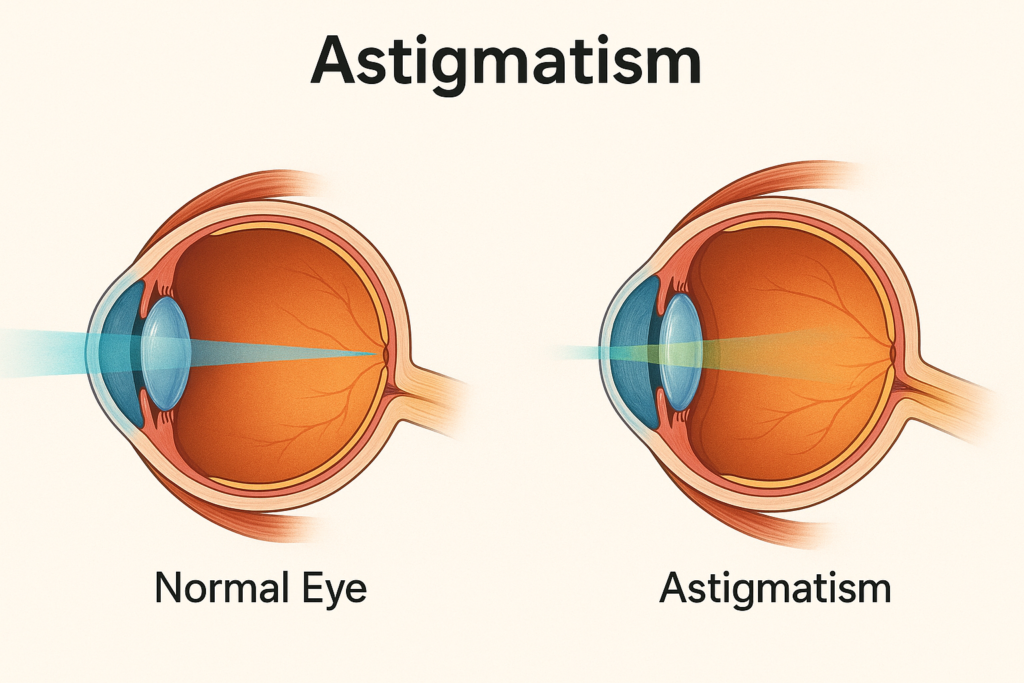Astigmatism is a common eye condition that leads to blurred or distorted vision, caused by an irregular shape of the cornea or lens. Many individuals who suffer from astigmatism rely on corrective eyewear such as glasses or contact lenses, but LASIK (Laser-Assisted In Situ Keratomileusis) offers a more permanent solution.
But does LASIK really fix astigmatism? In this blog, we’ll explore how LASIK works, its benefits, potential risks, who qualifies for the procedure, and alternative treatments for those who may not be eligible.
What is Astigmatism?
Astigmatism occurs when the cornea or the lens inside the eye has an abnormal or uneven shape. Instead of being perfectly round like a basketball, the cornea of an individual with astigmatism resembles the shape of a football. This irregularity prevents light from focusing correctly on the retina, leading to distorted or blurry vision at all distances.
Astigmatism Symptoms
People with astigmatism may experience:
- Blurry or distorted vision – Objects may appear stretched, shadowed, or duplicated.
- Eye strain and discomfort – Prolonged screen time or reading can lead to fatigue and headaches.
- Difficulty with night vision – Increased sensitivity to glare, halos, or streaky lights at night.
- Frequent squinting – Squinting may temporarily improve focus but can lead to eye fatigue.
Astigmatism Causes
The exact cause of astigmatism isn’t always clear, but common factors include:
- Genetics – Commonly passed down through family and typically present at birth.
- Eye injuries or surgery – Trauma or surgical procedures can alter the shape of the cornea.
- Keratoconus – A progressive eye disorder that causes the cornea to thin and bulge outward.
How LASIK Corrects Astigmatism

LASIK is a highly effective laser eye surgery that reshapes the cornea to correct refractive errors, including astigmatism. The procedure is quick, usually taking 15 minutes for both eyes, and involves three main steps:
Step 1: Creating a Corneal Flap
- A femtosecond laser or microkeratome blade creates a thin, hinged flap on the surface of the cornea.
- The flap is carefully lifted to expose the underlying corneal tissue for reshaping.
- This step is painless thanks to numbing eye drops, although you might feel slight pressure during the process.
Step 2: Reshaping the Cornea
- An excimer laser removes precise amounts of corneal tissue to correct its irregular shape.
- The laser is guided by a computerized mapping system, ensuring high accuracy based on each patient’s eye measurements.
- By smoothing out the uneven curvature, the cornea allows light to properly focus on the retina, significantly improving vision.
Step 3: Repositioning the Flap
- The corneal flap is carefully repositioned to its original place without the use of stitches.
- It naturally sticks in place within minutes, serving as a protective barrier during the healing process
- Most patients experience clearer vision within 24 hours, with continued improvement over the following days.
How Effective Is LASIK for Astigmatism?
LASIK is a highly successful treatment for correcting mild to moderate astigmatism, usually up to 5.00 diopters. By reshaping the cornea with a precise laser, LASIK helps light focus correctly on the retina, reducing blurry or distorted vision. Many patients see a marked improvement in their vision, with a high percentage reaching 20/20 vision or better. This often lessens or entirely removes the need for glasses or contact lenses. Additionally, advancements in laser technology, such as wavefront-guided LASIK, have improved outcomes by providing more customized corrections, enhancing clarity and reducing potential side effects like glare or halos.For a smooth recovery process, LASIK co-management ensures coordinated post-operative care between the surgeon and an optometrist.
Benefits of LASIK for Astigmatism
LASIK has helped millions of people achieve clear vision without relying on corrective eyewear. Here are some of the key benefits:
- Immediate Vision Improvement – Many patients notice clearer vision within 24 hours.
- Quick, Outpatient Procedure – The surgery takes about 15 minutes for both eyes, and recovery is rapid.
- Minimal Pain and Discomfort – The numbing eye drops ensure a painless procedure, with only mild irritation afterward.
- Long-Term Results – Once the cornea is reshaped, the correction is permanent, though age-related changes like presbyopia can still occur.
- Greater Convenience – No more dependency on glasses or contacts, especially for athletes or those with active lifestyles.
Potential Risks and Side Effects
While LASIK is highly successful, it’s important to be aware of potential side effects, which may include:
- Dry Eyes – A temporary reduction in tear production, usually improving within a few months.
- Glare, Halos, or Starbursts – Some patients experience night vision disturbances, which usually fade over time.
- Under or Overcorrection – In rare cases, enhancement surgery may be needed to fine-tune results.
- Flap Complications – Issues with flap healing, though uncommon, can occur if proper post-surgery care is not followed.
Are You a Good Candidate for LASIK?
Not everyone with astigmatism is eligible for LASIK. Ideal candidates typically:
- Have a stable vision prescription for at least one year
- Have mild to moderate astigmatism (up to 5.00 diopters)
- Have healthy corneas with adequate thickness
- Do not have keratoconus, severe dry eye, or other eye diseases
- Are at least 18 years old
To determine eligibility, an eye specialist will conduct a comprehensive eye exam, measuring corneal thickness, refractive errors, and overall eye health.
Alternatives to LASIK for Astigmatism
If LASIK isn’t suitable for you, other vision correction procedures may be an option:
- PRK (Photorefractive Keratectomy): Similar to LASIK but without a corneal flap, making it ideal for those with thinner corneas.
- LASEK (Laser Epithelial Keratomileusis): A hybrid of LASIK and PRK, where the corneal surface layer is preserved.
- SMILE (Small Incision Lenticule Extraction): A minimally invasive laser procedure effective for myopia and some forms of astigmatism.
- Implantable Contact Lenses (ICL): Permanent lenses inserted into the eye to correct vision without corneal reshaping.
- Refractive Lens Exchange (RLE): Similar to cataract surgery, replacing the natural lens with an artificial one for vision correction.
Take the First Step Toward Clear Vision
If you’re frustrated with depending on glasses or contacts because of astigmatism, LASIK may be the transformative solution you’ve been seeking. With high success rates and rapid recovery times, many patients experience newfound visual freedom within just days of the procedure.Still unsure if LASIK is right for you? Schedule a consultation at Vision Gallery today!Our experienced team will assess your eye health, explain your treatment options, and guide you in making a well-informed choice. Your journey to crystal-clear vision starts here!






